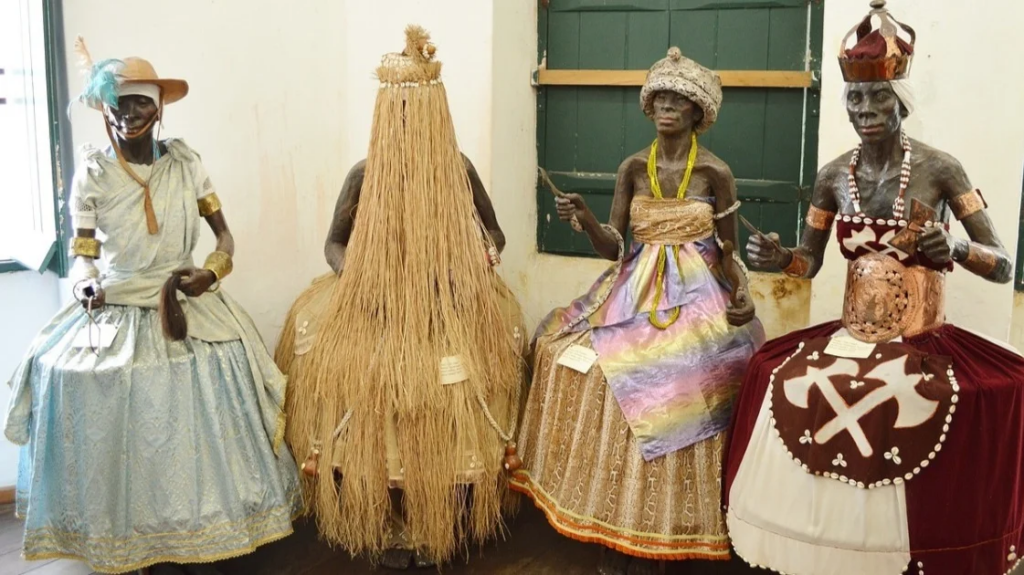Advertisement
Umbanda is one of Brazil's most fascinating religions, with a rich history, a complex theology and a diverse spiritual practice. In this content, we will explore the foundations of Umbanda, its main Orixás and some of the curiosities that make this religion so unique.
Fundamentals of Umbanda
Umbanda, as a Brazilian religion, has a rich theological and philosophical basis, which has developed over time through the fusion of different religious and cultural influences. Its foundations are essential to understanding not only the religious practice itself, but also its unique position in Brazilian society and its relevance to millions of practitioners across the country.
Advertisement
Plurality and Inclusion
One of the most striking fundamentals of Umbanda is its inclusive and pluralistic nature. The religion welcomes people from all ethnic, social and cultural backgrounds, offering a space where different religious traditions can coexist and integrate harmoniously. This is reflected in the diversity of Umbanda practitioners, which includes people of African, European, indigenous and Asian descent.
Belief in a Supreme God
Although Umbanda recognizes the existence of multiple Orixás and spiritual entities, it also believes in one supreme God, who is conceived in different ways depending on the line of Umbanda followed. This God is often described as transcendent and immanent, the creator of all things and the source of love and mercy.
Advertisement
Spirits and Mediumship
Umbanda values communication with the spirit world and the practice of mediumship as a means of accessing knowledge, guidance and spiritual healing. Mediums play a central role in the religion, serving as channels between the living and the dead and enabling the manifestation of spiritual entities during rituals.
Charity and Helping the Needy
One of the pillars of Umbanda is the principle of charity and helping those in need. Umbanda terreiros often offer spiritual, material and emotional assistance to local communities, through services such as spiritual healing sessions, food distribution and psychological support.
Worship of the Orishas and Spiritual Entities
The Orixás play a central role in Umbanda and are venerated as deities who govern different aspects of nature and human life. In addition to the Orixás, the religion also worships a variety of spiritual entities, such as caboclos, pretos velhos, children and exus, each with their own history, characteristics and influences.

These are just some of the fundamentals that underpin the practice and belief in Umbanda. However, it is important to emphasize that the religion is dynamic and is always adapting and evolving to meet the spiritual and social needs of its practitioners, while keeping its essence and fundamental values alive.
Orishas in Umbanda
The Orixás play a fundamental role in Umbanda and are considered to be deities who govern different aspects of nature and human life. Each Orixá has specific characteristics and is worshipped in a different way, through rituals and offerings.
Oxalá
Within Umbanda's pantheon of Orixás, Oxalá is revered as a figure of great importance and significance. He is seen as the father of all the Orixás, the creator of the universe and the holder of peace and harmony. His representation is often associated with the color white, which symbolizes purity and tranquillity.
- Father of All Orishas: Oxalá is considered the patriarch, the progenitor of all the other deities in Umbanda. He is venerated as the one who created the world and all forms of life in it. His position as father of the Orixás underscores his authority and importance in the religious pantheon.
- Lord of Peace and Harmony: Oxalá is also known as the Orisha of peace and harmony. His energy is seen as calming and purifying, capable of bringing balance and serenity to those who seek his guidance. In Umbanda ceremonies, invoking Oxalá is often done in order to promote concord and understanding between people.
- Representation of Oxalá: In visual representations, Oxalá is usually depicted as an elderly man dressed in white, symbolizing his purity and wisdom. He can be represented holding a staff or a sceptre, indicating his divine authority. His image can also be associated with other symbols, such as the sun and the moon, which represent the duality and totality of the universe.
Worship and offerings
Rituals dedicated to Oxalá usually involve offerings of white elements, such as flowers, candles and soft perfumes. Water is also an element often used in his rituals, symbolizing purification and renewal. Ceremonies in honor of Oxalá are usually held on specific days, such as Fridays or during religious festivities dedicated to him, such as Oxalá Day.
Iemanjá
Within Umbanda's pantheon of deities, Iemanjá occupies a prominent place as one of the most revered and beloved entities. She is revered as the queen of the sea, protector of fishermen and families, and is associated with motherhood, fertility and protection.
- Queen of the Sea: Yemanjá is revered as the goddess of the seas, oceans and salty waters. Her energy is deeply linked to the vastness and immensity of the ocean, reflecting her maternal and welcoming nature, but also powerful and imposing. She is considered the mother of all human beings, caring for and protecting those who invoke her help.
- Protector of Homes and Families: In addition to her association with the sea, Iemanjá is also considered a protector of homes and families. She is invoked to protect loved ones, ensure family harmony and grant blessings of prosperity and fertility. Her role as a mother is emphasized in ceremonies dedicated to her, where it is common to ask for her intercession in matters related to motherhood and raising children.
- Representation of Iemanjá: In visual representations, Iemanjá is often depicted as a tall, slender woman with long wavy hair and dressed in shades of blue and white, colors associated with water and purity. She may be depicted holding a mirror, a fan or a trident, symbols of her connection to the sea and her power over the waters.
Worship and offerings
Offerings to Iemanjá usually include elements related to the sea, such as white flowers, soft perfumes, jewelry, mirrors, combs, fruit and sweets. These offerings are placed in the sea as a way of honoring and thanking the goddess and also as a request for protection and blessing for those who offer them.
The most common day for paying homage to Iemanjá is February 2, when thousands of devotees head to the beaches to make their offerings and prayers.
Ogum
Ogum is one of the most prominent and revered entities in Umbanda's pantheon of Orishas. He is often portrayed as the valiant warrior, the protector of battles and the lord of strength. His presence is invoked for protection, courage and determination, and he is considered a great ally in the spiritual journey and in overcoming challenges.
- Valiant warrior: Ogum is revered as the Orisha of war and struggle. His energy is associated with the courage, determination and discipline needed to face life's challenges with bravery and resolution. He is invoked in times of conflict and difficulty, offering strength and protection to those who call upon him.
- Protector of Battles: In addition to his role as a warrior, Ogum is also seen as a protector of battles, both physical and spiritual. He is invoked to ward off enemies and adversaries, guaranteeing the safety and victory of those who seek his protection. His presence is often felt in situations of conflict and danger, where his strength is invoked to overcome obstacles and achieve success.
- Lord of the Forge and Technology: Another important aspect of Ogum is his association with metallurgy, technology and the mechanical arts. He is considered the lord of the forge, the master of blacksmiths, and his mastery of fire and metal symbolizes not only his ability to forge weapons and instruments, but also his ability to transform and shape reality according to his will.
Worship and offerings
Offerings to Ogum usually include elements related to war and protection, such as metal weapons, knives, swords, shields, red candles and alcoholic drinks. These offerings are made as a way of honoring and thanking the Orisha and also as a request for his protection and blessing on those who offer them. The most common day for paying homage to Ogum is Tuesday, the day traditionally associated with him.
Shango
Xangô is one of the most striking and revered figures in the Umbanda pantheon of Orishas. He is often portrayed as the lord of justice, order and thunder. His presence is invoked to balance forces, promote justice and guarantee harmony between human beings and the Orixás.
- Lord of Justice: Xangô is revered as the Orisha of justice and balance. His energy is associated with impartiality, honesty and integrity, representing the ethical and moral principles that govern human conduct. He is invoked in legal matters, disputes and conflicts, ensuring that justice is done and that everyone's rights are respected.
- Protector of Order: In addition to his role as guardian of justice, Xangô is also seen as a protector of order and discipline. He is invoked to maintain harmony and balance in the world, warding off chaos and disorder. His energy is often felt in times of turbulence and instability, where his presence is invoked to restore peace and tranquillity.
- Lord of Thunder: Xangô is often associated with thunder and lightning, symbolizing his strength and power. He is seen as the lord of storms, capable of purifying and renewing the earth with his electrical energy. His presence is felt in the skies during storms, where his resounding voice is heard as a reminder of his divine authority.
Worship and offerings
Offerings to Xangô usually include elements related to justice and authority, such as axes, stones, swords, brown and red candles, and foods such as corn, peanuts and black-eyed peas. These offerings are made as a way of honoring and thanking the Orixá and also as a request for his protection and blessing on those who offer them. The most common day for paying homage to Xangô is Wednesday, the day traditionally associated with him.
Oxum
Oxum is one of the most beloved and revered entities in Umbanda's pantheon of Orixás. She is often portrayed as the goddess of love, beauty, fertility and sweetness. Her presence is invoked to promote self-love, sensuality and prosperity.
- Goddess of Love and Beauty: Oxum is revered as the goddess of love and beauty, representing femininity, sensuality and grace. Her energy is associated with sweetness, gentleness and charm, inspiring feelings of love and admiration in all those who come into contact with her. She is seen as a protector of women and a guide in matters of the heart.
- Protector of Fertility: In addition to her role as goddess of love, Oxum is also seen as a protector of fertility and motherhood. She is invoked to bless women who wish to conceive children, ensuring a healthy pregnancy and a safe birth. Her energy is seen as nurturing and welcoming, creating a favorable environment for life to flourish.
- Lady of Fresh Waters: Oxum is often associated with fresh waters, such as rivers, lakes and waterfalls. She is seen as the lady of waters that purify and revitalize, symbolizing renewal and the constant flow of life. Her presence is felt in the gently flowing waters, bringing with them the promise of love, prosperity and happiness.
Worship and offerings
Offerings to Oxum usually include elements related to femininity, fertility and sweetness, such as yellow flowers, sweet perfumes, mirrors, combs, jewelry and sweets. These offerings are made as a way of honoring and thanking the goddess and also as a request for her protection and blessing for those who make them. The most common day for paying homage to Oxum is Saturday, the day traditionally associated with her.
Oxossi
Oxossi is one of the most significant and revered entities in the Umbanda pantheon of Orishas. He is often represented as the brave hunter, the protector of the forests and animals. His presence is invoked to promote harmony with nature, the protection of forests and ecological balance.
- Protector of the Woods and Animals: Oxossi is revered as the Orisha of hunting and the forest. His energy is deeply connected to nature, forests and animals, representing the wisdom and harmony of the natural world. He is seen as a guardian of the forests, protecting natural habitats and the animal species that inhabit them.
- Valiant hunter: In addition to his role as protector of the forests, Oxossi is also known as a skilled and courageous hunter. He is invoked to grant success in the hunt and in the search for food, guaranteeing the subsistence and livelihood of communities that depend on nature to survive. His energy is associated with the cunning, dexterity and determination needed to face the challenges of life in the jungle.
- Lord of Healing and Prosperity: Oxossi is also seen as a healer and a provider of prosperity. His energy is seen as healing and revitalizing, bringing health and well-being to those who seek his help. He is invoked in rituals of healing and renewal, where his presence is felt as a blessing of vitality and abundance.
Worship and offerings
Offerings to Oxossi usually include elements related to nature, hunting and the protection of the forests, such as forest fruits, aromatic herbs, arrows, bows, green candles and alcoholic drinks. These offerings are made as a way of honoring and thanking the Orixá and also as a request for his protection and blessing for those who offer them. The most common day for paying homage to Oxossi is Thursday, the day traditionally associated with him.
Nanã Buruquê
The oldest of the deities, Nanã is associated with wisdom, ancestry and transformation. Her color is lilac and her offerings include cooked food and water.
These are just a few examples of the many Orixás present in Umbanda, each with their own history, characteristics and influences.
Curiosities about Umbanda
In addition to its rich mythology and complex rituals, Umbanda is also surrounded by various curiosities that reflect its diversity and its adaptation to the Brazilian context.

- Religious syncretism: Umbanda is known for its ability to incorporate elements from different religious traditions, resulting in a unique and inclusive spiritual practice.
- Chants and dances: Umbanda rituals often include chants and dances, which are used to evoke the presence of the Orixás and promote spiritual connection between the participants.
- Mediumistic work: Mediums play a central role in Umbanda, acting as intermediaries between the spirit world and the earthly world. They are responsible for incorporating spirit entities during rituals and transmitting their messages and guidance.
- Festivals and celebrations: Umbanda has various festivals and celebrations throughout the year, which mark important dates in the religious calendar and allow practitioners to reinforce their faith and devotion to the Orixás.
Umbanda is a fascinating religion that combines elements from various religious and cultural traditions, resulting in a rich and diverse spiritual practice. Its foundations, its Orixás and its curiosities reflect the complexity and beauty of this unique Brazilian religion.
See also: The Importance of Spirituality in the Digital Age: How Technology Affects Our Religious Practice
March 30th, 2024

She has a degree in Languages - Portuguese/English, and is the creator of the Escritora de Sucesso website. As a writer, she seeks to expand everyone's knowledge with relevant information on various subjects. At SoMuchToSayToday, she brings news and content ranging from entertainment to the country's economic situation.



